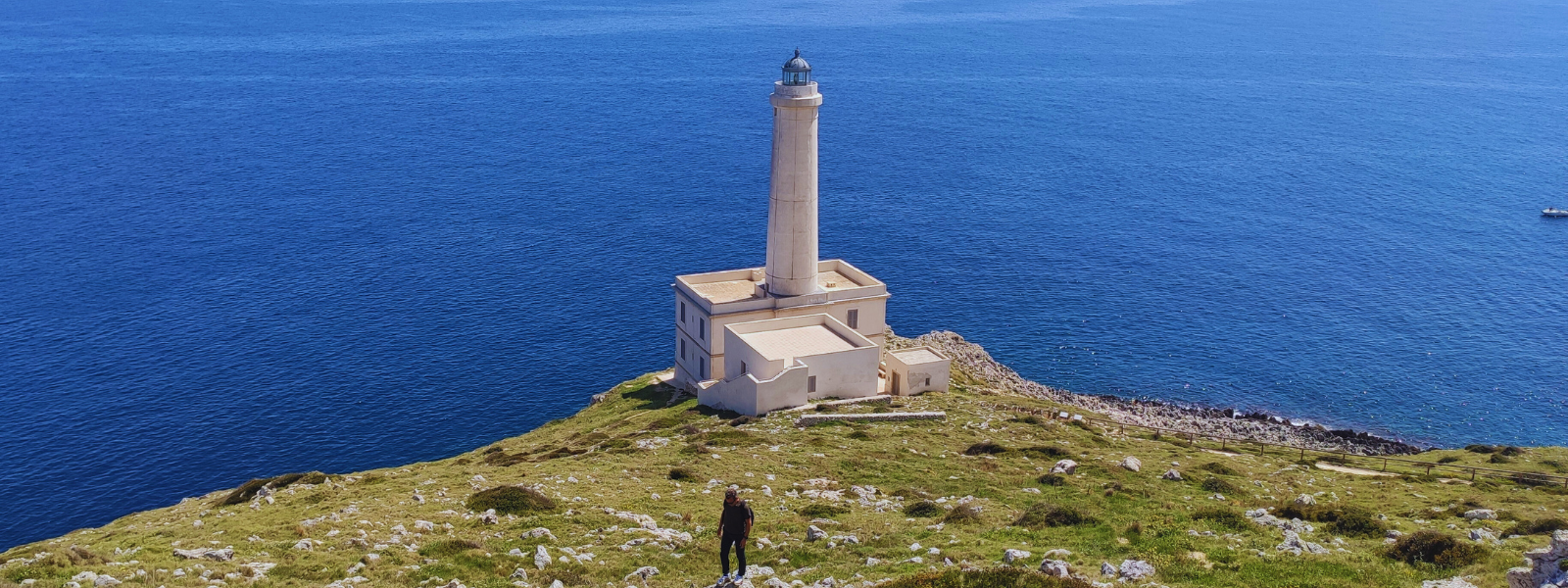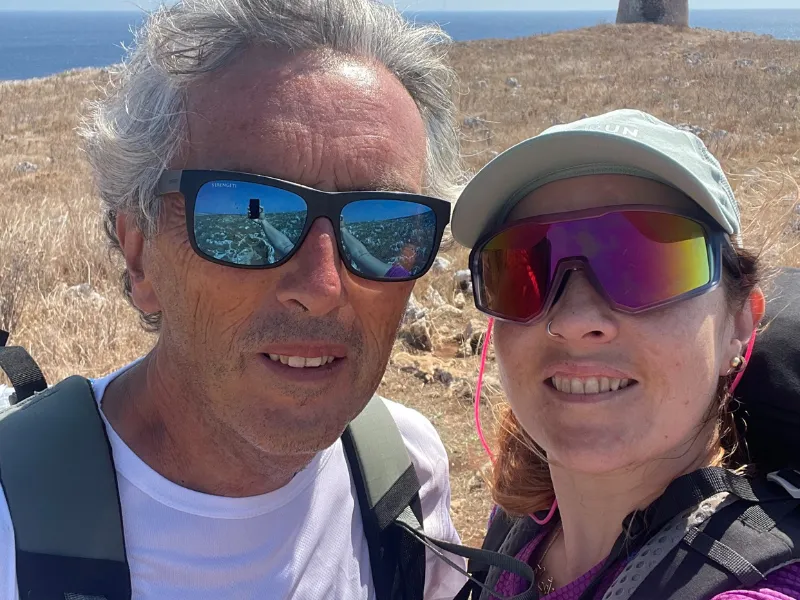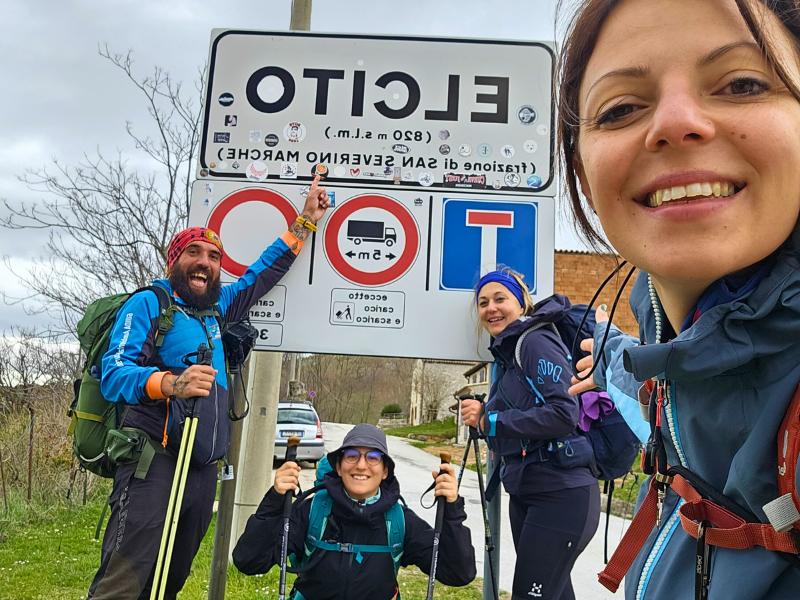Gabriele tells us about his new journey in southern Apulia, the Salento Trail with the gaze of one who seeks not feats but details. Leaving from the Veneto with the curiosity of someone who has listened a thousand times to the stories of others, he will travel in five stages this tongue of land jutting out into the sea, crossing landscapes that change discreetly, among ruined farmhouses, cliffs that look like miniature models, festive villages and silences interrupted by the wind. Her journey is made up of chance encounters, thoughts on the sidelines, shared foods and small revelations. A diary at a human pace, where every detour and pause becomes part of the story.
Do you also feel like sharing your walking experience with our community? Email us at info@camminiditalia.org and we will send you all the information you need to tell your adventure. If you prefer, you can also join our Facebook Community and share your story directly there.
And if you want to make sure you don’t get lost along your route, remember to download the Cammini d’Italia app before you leave! With it you’ll have all the gpx tracks of many Italian walks at your disposal and you can navigate easily, even offline. Find out more at this link!
What I am about to recount is a journey of discovery of a piece of Italy, one of the most remote, a peninsula within a peninsula. It is called Salento. It is so far from my homeland, Veneto, that it seems like a mirage on the horizon. Yet, I have been told a thousand times by returning vacationers: it really exists, and in summer it is overflowing with life, between sunny cliffs and beach towels covering every available space. After years of stories I decide it is time to see it for myself.
To travel through Salento in spring is a privilege. It means experiencing this land before summer overwhelms it, catching it in its most authentic balance. The itinerary, divided into five well-balanced and never too demanding stages, takes the walker through an extraordinary sequence of places, between famous destinations and hidden corners, reserving not a few twists and turns. As in the best movies.
Stage 01: Lecce – San Foca
One leaves Lecce as one leaves any city: on paved suburban roads. Nature, however, doesn’t seem to mind: it’s spring, she knows it’s her turn, her moment to shine as the leading actress. And so it is that the roadside is overflowing with flowers with a chromatic variety to which I am not accustomed. Beyond the roadside the fields are dotted with farms, sometimes preserved, sometimes in ruins. I observe one from a distance, imagining renovating it and breathing life back into it like in the movie “Us and Julia.” What can you do: professional deformation.

Along the way, walkers and walkers chase each other at a brisk pace. It is with some of them that I discover the village of Acaya and drink my first coffee from Lecce. Acaya is a magical place, a fortified citadel with a courtyard out of time. A coat of arms stands out on the ramparts, the same one that the barmaid imprints on us on the Pilgrim’s Passport.
After a break, the walk continues and the asphalt gives way to a dirt path, surrounded by olive trees and a few eucalyptus trees. I notice that the olive trees look like survivors. Maybe a fire? The famous Xylella? Yet, even if a bit battered, they retain their charm. I continue along the path, which slopes gently toward the coast. It is not long to go and, all of a sudden, there is finally the sea! The cobalt blue color contrasting with the grayish-white sand of the coast. The wind is blowing hard, and windsurfers are taking advantage of it. It may be the exhilaration of a Venetian facing the sea of Puglia, but all of a sudden I feel like I am on a remote Australian beach.
The walk continues along the coast, under the heat of the sun and the breeze of the wind. Approaching San Foca, the sand gives way to a low cliff that resembles a 1:10 scale model. Walking like giants along these miniature rock formations, we finally reach San Foca. After the asphalt and sand, it is time to enjoy a well-deserved afternoon rest.
In the evening I reach the center of the town. San Foca is a small seaside town that lacks nothing except perhaps a real square. But in the end, it is the people who create the square: walkers and tourists gather in the bars near the main crossroads, where aperitifs are the perfect time to exchange a few words about the Stage that has just ended. And the aperitivo soon becomes dinner, and I find myself at the table with other pilgrims who share the goal with me. The seafood menu is joined by the local must-have “fave e cicoria.”
And while we enjoy the Salento gastronomy, here is an off-menu item: the restaurant manager illustrates to all diners the first kilometers of the next stage. To do so, he uses a panoramic photograph that takes up the entire long side of the room, lit from below to dramatic effect. Aided by a cue stick as a pointer, he introduces us to the second stage with the same verve as an American tech guru explaining the product of the year. There, listening to him, I realize I am in the right place.
Tip of the day: stock up on food in San Foca. The next stop offers few supply points.
Gabriel is walking along the Sea Route. Did you know that there was also the Via dei Borghi?
Stage 02: San Foca – Otranto
The second stage, developed along the coast, does not seem to begin under the best auspices: the veiled sky threatens rain and partly spoils the visit to the poetry cave, a natural pool a stone’s throw from the sea, a sheet of blue water in the middle of the ochre cliffs. Marco recounts that, as a child, he used to come here on vacation and that it was quite normal to walk down the staircase carved in the stone to dive into the water.
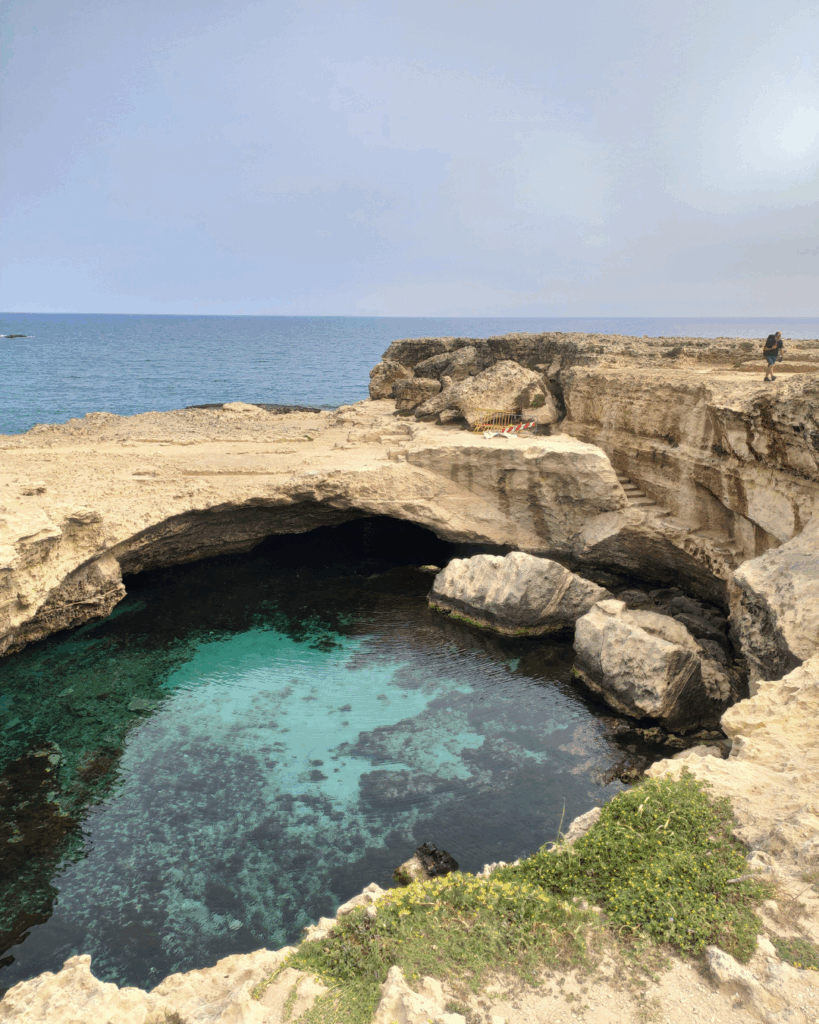
As is often the case, disappointments are the antechamber for the most incredible surprises. Arriving by sea at Torre dell’Orso, I discover one of the most fascinating places in Puglia, a sequence of sheer cliffs bordered by yellow flowers on a bluish sea that needs no Instagram filters. The Mediterranean version of Ireland’s famous Cliffs of Moher. The color of the water is identical to the color of my T-shirt, which I received at the 2025 Festival of Walks.
My pace slows down, the frequency of photographs increases. I understand that the place is also special from the presence of tourists who have come there specifically to admire the stacks of St. Andrew. Many, but probably few compared to those found there in summer.
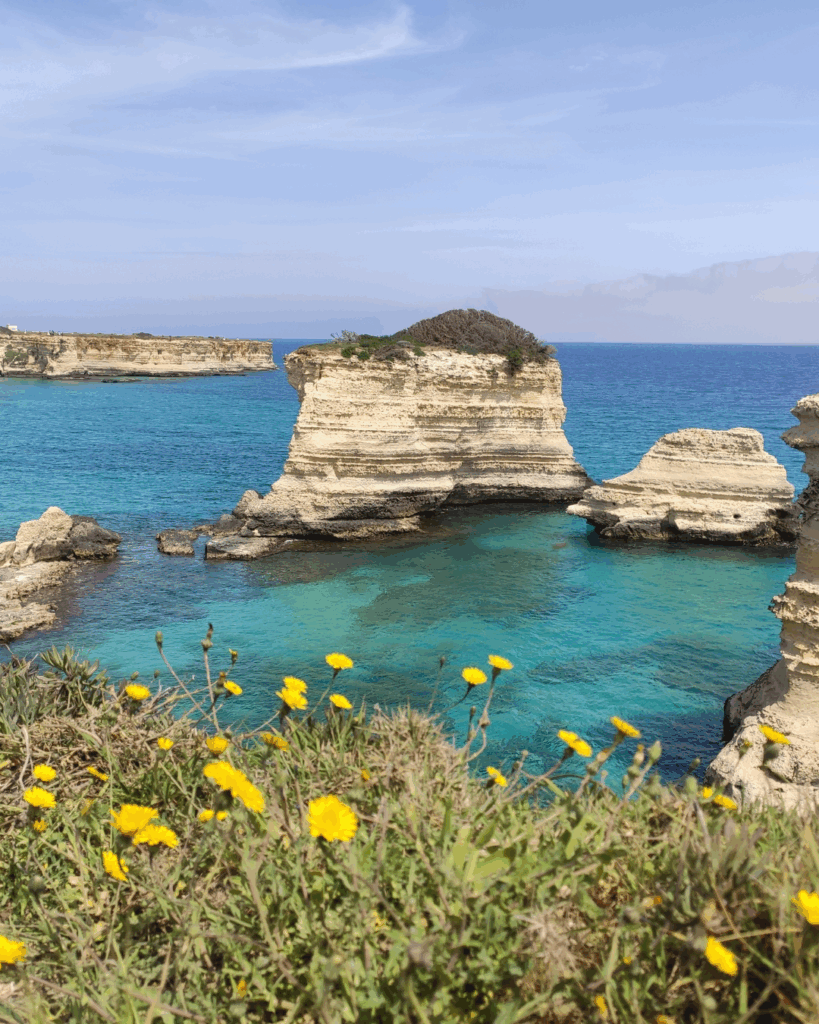
It is late, we must set off again and say goodbye to this paradise. The route continues along an endless beach of golden sand to the Alimini lakes. There I find Marco who, heedless of the lashing wind and icy water, has just improvised a swim, and Franca, resting in the shade of a kiosk still slumbering in anticipation of summer. My pause is brief; I point sharply toward Otranto, following the coast through paths and pine forests. For a stretch the path winds around a tourist village, then turns into agricultural landscape.
The agricultural landscape transforms into the city, a bustling and crowded town. Suddenly, the curtain of outlying houses opens up in front of me, revealing an extraordinary panorama: the stone church of the Madonna dell’Altomare to my left, the beach of the terraces below, and the old town perched opposite in the distance. Otranto is a walled city overlooking the sea, just like the King’s Landing from Game of Thrones.
“O of Otranto,” reads the Italian spelling. Indeed, Otranto can only be an “O,” so enclosed are the walls, built as a bulwark against the Ottomans. Inside, life flows, symbolized by the Tree of Life, depicted in the mosaic on the cathedral floor.
Tip of the day: enjoy wine and local products in the heart of the old town. You will feel like you are on a Greek island or perhaps in Morocco.
Stage 03: Otranto – Santa Cesarea Terme
The path starts again from Otranto slightly uphill along a scenic promontory that leads to a first lookout tower. My gaze jumps from breathtaking sea views to Mediterranean scrub, but something draws my attention to the ground on the path. Reddish pebbles with a pseudosphèric shape dot the path. I find myself following them, almost as if they were the tracks left by Tom Thumb, and soon realize that they anticipate Otranto’s famous bauxite quarry.
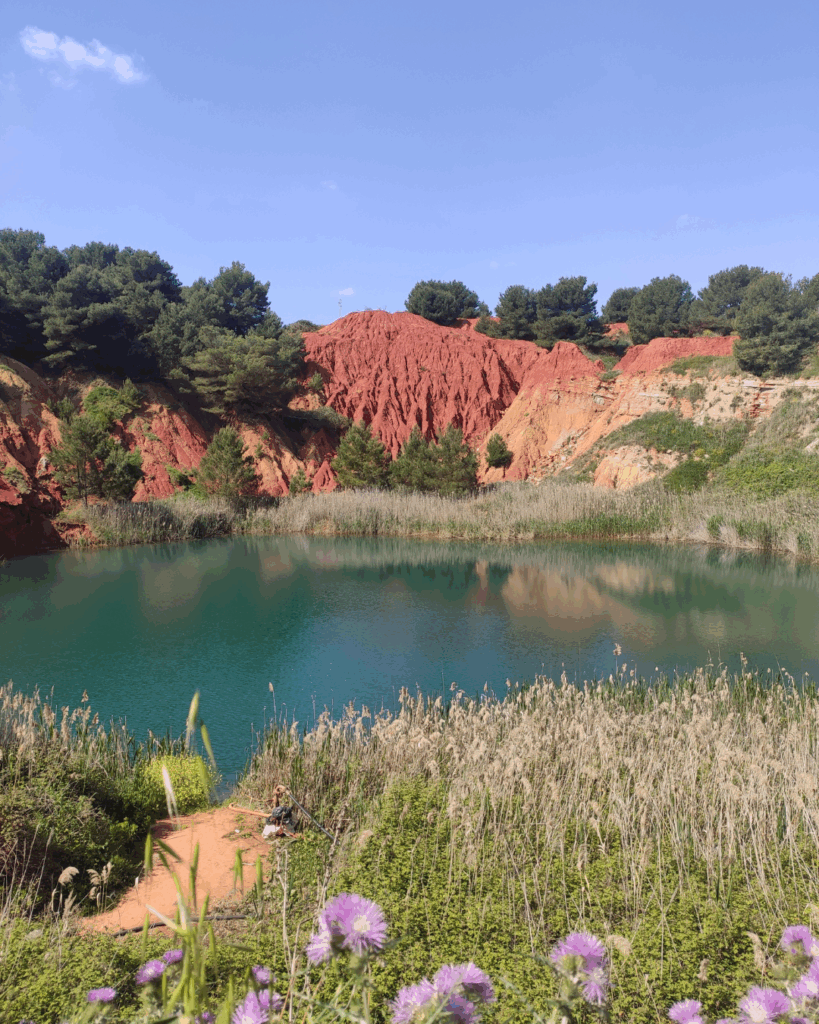
The disused bauxite quarry with its emerald green pond and red earth banks is a social media star. The curiosity is great, the fear that reality will betray expectations even more so. Together with Clara I approach this artificial crater. There are an infinite number of pebbles there: getting warm! We go up a slope and access the quarry: fire! Fire is also the color of the quarry. Even without filters, the place is magical and many are the tourists magnetized by this attraction. I get a camouflage photo taken in my present-day, salmon-colored shirt.
We set off again along beaches and headlands to the watchtower of St. Emiliano. I take a break. From here the view sweeps 360 degrees between the coast and inland fields bordered by dry stone walls. When I resume the path the sky turns hazy. I look back at the silhouette of the tower on the gentle outline of the headland under the cerulean sky, behind an expanse of vegetation and a few giant boulders. Am I in the Scottish highlands?

There is still a long way to go among sea views and wind-bent trees when I finally reach Santa Cesarea Terme where I find Franca again, intent on contacting lodging. Today a singular arrangement awaits us: the rectory house. And while we wait in the churchyard, the parish priest’s appointee, Salvatore Giovanni aka Mister Ninì, arrives and welcomes us by telling us the history of the place.
That this was not the usual seaside resort was already clear from the white architecture with oriental shapes, and Mr. Ninì confirms it for us: the town has experienced a golden age as a casino and spa resort and is now reinventing itself. Can the path of Salento make a difference? In the meantime, we await the upcoming opening of the caves with sulfur water that mister Ninì tells us passionately about.
Tip of the day: get to Santa Cesarea on time, otherwise you may find yourself sleeping on the creakiest bed in the rectory.
Stage 04: Santa Cesarea Terme – Marina Serra/Tricase
I travel the fourth stage on April 25. After ascending an initial stretch of paved coastal road I read an inscription that reads “We are the waves of a great sea.” The best (unwitting) subtitle for today’s anniversary. The road I am traveling leads to the town of Castro. I take the main avenue and find myself in front of an orderly and very elegant crowd: it is a procession, complete with band. I realize that I am the only one in sportswear and the only one walking down the street that way. I have no choice but to stop and observe the scene. When I finally enter the village all becomes clear because the village is overrun with illuminations. I have arrived on the day of the patronal festival!
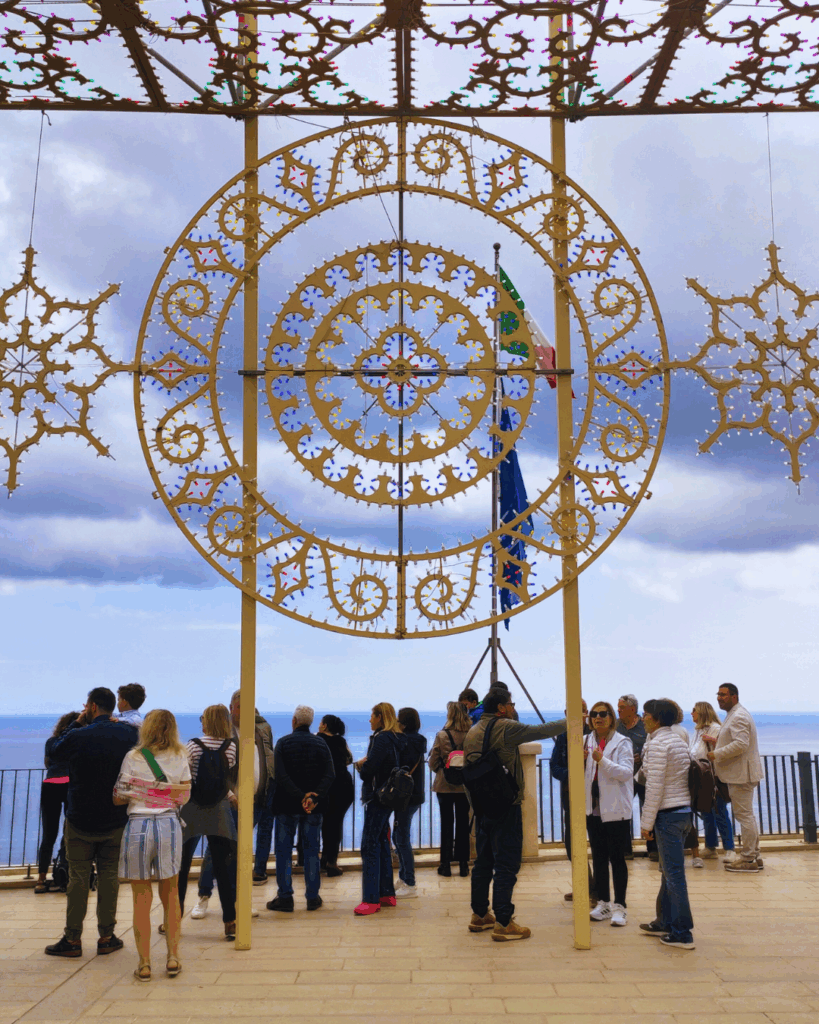
I stop in the main square, squeezed between the terrace overlooking the sea and the castle ramparts: the name “Castro” does not betray expectations. In the square all the pilgrims who are walking the Salento route arrive in a bunch: there are dozens of them. Among them is Claudia, who advances stoically despite two days of nausea from unidentified food. On the strength of her medical knowledge, she tried to treat herself with Coca Cola but failed, so now she is reaching for some Imodium.
The path continues downhill to Acquaviva Cove, a beach with blue water and, it is said, as icy in winter as it is in summer. I dip my feet in the water to verify: confirmed. It is then time for lunch. We toast: I have a spritz, Claudia a canteen with water with an aftertaste of Imodium.
After lunch we proceed into the coastal countryside of Salento where nature takes center stage. Using an app we get acquainted with the local flora and its cute names. Continuing on, a local resident also tells us about the Vallonea Oak, a very rare, centuries-old plant. We would like to reach it but distances prevent us from doing so.
On this Stage I am forced to make a detour due to a shortage of accommodations in Marina Serra, and like me many. We will have to sleep in Tricase: alas, I skip the natural pools of Marina Serra but discover a lively inland village with the appearance of a small Lecce.
Tip of the Day: if you want to stay in Marina Serra book months in advance, especially around holidays.
Stage 05: Tricase – Santa Maria di Leuca
After four days of sun and wind, it is time to put on the waterproof jacket. I almost regretted not having made use of all the luggage. Here I am satisfied: after crossing the square of Corsano, sunny and covered only by a curtain of colorful embroidery, here comes the sky to cover itself. And immediately the sun becomes rain. And the rain becomes a torrent on the downhill road leading to the Novaglie Lido.
But when I am now resigned to getting wet from head to toe, I see Benedict and his companion sheltering under the balcony of a house under construction, with the approval of the workers working there. I imitate them and joke about having lunch in the living room under construction. Together with other walkers I decide to set off again in the rain, but after a few meters a restaurant materializes on the path, as if it were an oasis but in reverse: dry.
After lunch, the route continues uphill in the direction of Cipolliane Cave. To get there, it is necessary to detour onto an impassable path. And while deciding whether to leave the backpack, I realize that I forgot my trekking poles at the restaurant. And here’s the real fork in the road: do I descend with to the Cipolliane with the other walkers or do I go to retrieve the poles with which I have walked all my walks since 2018? I choose company and we descend.
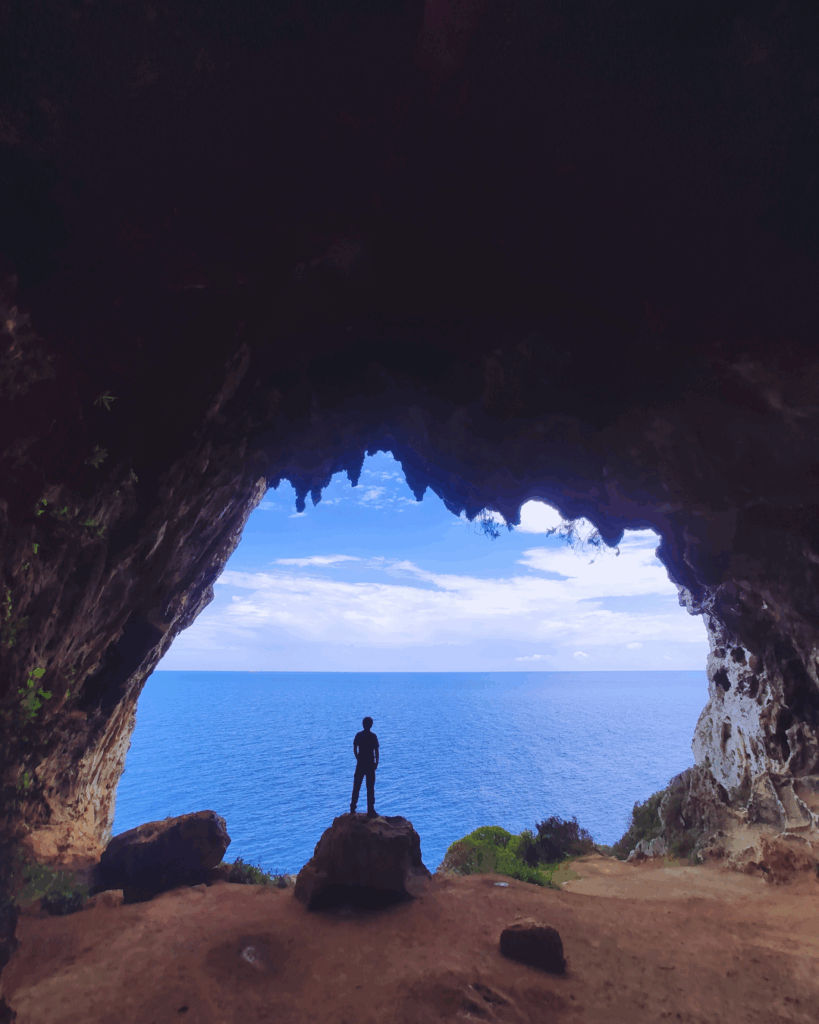
The cave has walls historiated with fossil shells and a large opening framing the sea. We all sit and contemplate it and take backlit photos of our silhouettes on a boulder in a panoramic position. Silence. Sofia throws out a metaphysical question, “Why is man so attracted to water?” Just enough time to gather some answers and it’s time to leave again.
The route after Cipolliane continues scenic and challenging to Ciolo, where a concrete arch bridge crosses an inlet, a destination for extreme dives that are confirmed to me by the bartender. From the Ciolo the path proceeds uphill. Here I meet a couple in the opposite direction and she, pointing at him, says, “he’s been telling me all day how beautiful and unique his T-shirt is, the same one you have.” I look at my t-shirt, now green, and go on laughing.
The walk ends with a soft path through the countryside to reach, through the harbor, Santa Maria di Leuca. There the last effort awaits us: the staircase of 283 steps (they say) that leads to the sanctuary. At the top, a vast square with the obelisk in the center. As a backdrop, the church of Santa Maria de Finibus Terrae and a sequence of arches. It is time for the last stamp and group photos. There are Marco, Claudia, Franca, Clara, Sofia, Benedetto and his partner. The yellow of the Apulian stone. The blue of the sky. The white of the lighthouse. White like the color that gives its name to this part of the world where the earth ends.
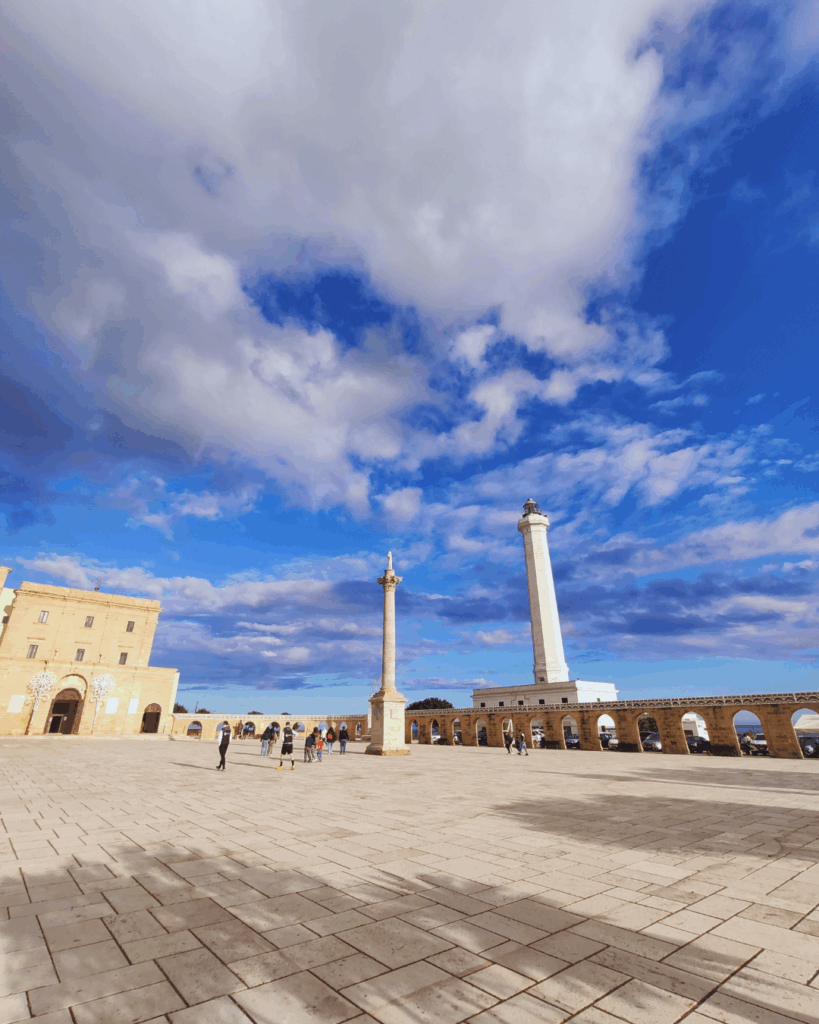
Tip of the Day: if you want Testimonium remember to reserve it. But you can also do without it because, as with trekking poles, there are more important things.
Freedom has a path-or 100! In our Atlas of the Paths of Italy find lots of routes to explore Italy from North to South.
